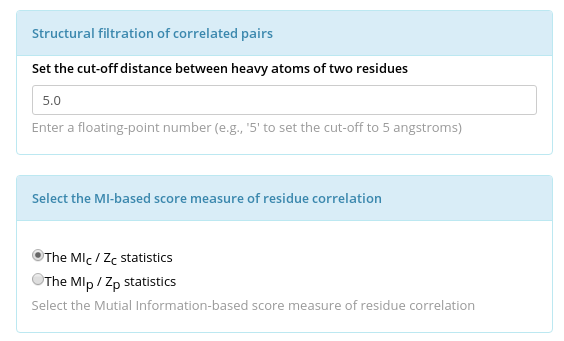visualCMAT parameters

The Structural filtration of correlated pairs. The purpose of this filter is to classify the predicted co-evolving pairs into networks of physically interacting correlated residues and long-range correlations. A pair of correlated residues i and j is classified as interacting if the distance between them is within the cut-off (direct physical interaction), or if the distance between them and the same ligand (e.g., a substrate or a structural water molecule) is within the cut-off (mediated interaction). The structural filtration can solve the problem of so called "chaining effect", i.e. when a pair of positions i and j demonstrate correlation not as a result of structural or functional adaptation but rather as a consequence of both i and j having an important interaction with residue at position k. The long-range correlations (pairs outside the networks) will be disabled by default in the visualCMAT output file but can be re-enabled by the user. The default value for this parameter is 5 angstroms to include hydrophobic interactions.
The MI-based score to create the visualCMAT output. The CMAT algorithm, which is implemented by the visualCMAT, calculates two independent scoring functions to estimate the residue correlation - the MIc / Zc and MIp / Zp statistics. Both statistics are used to select the most significant correlations by the CMAT algorithm (see the Minimum Zp and Minimum Zc filtering parameters in the CMAT options), but only one of them is used to compile the visualCMAT output. The visualCMAT annotations created with either of the two statistics are equivalent (the default is MIc / Zc).
The CMAT options. The Mutual Information based CMAT algorithm [Jeong & Kim, 2012] is implemented to predict the correlated mutations/co-evolving residues by the visualCMAT server. For the description of the CMAT parameters please refer to the CMAT documentation. Generally speaking, the CMAT algorithm usually does not require task-specific fine tuning of the parameters and the default values can be implemented in the majority of cases.